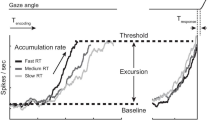Abstract
Saccades are defined as rapid eye movements that occur between gaze fixation and the desired object and can be either reflexive or voluntary. These voluntary gaze movements are made of a coordinated series of head and eye movements that have been modeled by a dynamical system and are quick or slow. In particular, one of the purposes of modeling saccadic eye movements based on mathematical dynamical models is to anticipate the experimental data behavior of this system. Considering how it is possible to enhance the saccadic model based on its basic model, namely the burst neurons and resettable integrator model, we introduce alternative functions that can more effectively represent the response of the bursters to an error signal. So, we utilize a special sigmoidal function, that is, the logistic function, and the Naka-Rushton function. These functions are exceedingly close to the experimental data and contribute to solving the absence of a derivative at the equilibrium point in the original saccadic model. Employing new functions, we also investigate the dynamical behavior of the modified saccadic model, in which the role of omnipause cells is considered, and evaluated the stability, instability, and existence or lack of bifurcation. Since the saccadic model has a lot of parameters that can change, we use simulation results to compare the changes of the phase portrait and time series in special and fundamental conditions. Another focus of the numerical simulations is to compare the changes in the model’s main factors against each other, i.e., left burst neuron, right burst neuron, motor error, and fringe rates.




















Similar content being viewed by others
Data Availability Statement
All data generated or analyzed during this study are included in this published article.
References
S.H. Ather, Catastrophe theory in work from heartbeats to eye movements. Biol. Cybern. 115(1), 39–41 (2021)
R. Engbert, R. Kliegl, Mathematical models of eye movements in reading: a possible role for autonomous saccades. Biol. Cybern. 85(2), 77–87 (2001)
V. Kuperman, J.A. Van Dyke, R. Henry, Eye-movement control in ran and reading. Sci. Stud. Read. 20(2), 173–188 (2016)
H. Li, J. Luo, J. Chen, Z. Liu, S. Xie, Development of robot bionic eye with spherical parallel manipulator based on oculomotor control model. Organ 1, 12 (2012)
O. Akman, Analysis of a nonlinear dynamics model of the saccadic system. PhD thesis, University of Manchester Institute of Science and Technology (UMIST) (2003)
O. Akman, D. Broomhead, R. Abadi, R. Clement, Eye movement instabilities and nystagmus can be predicted by a nonlinear dynamics model of the saccadic system. J. Math. Biol. 51(6), 661–694 (2005)
O. Akman, D. Broomhead, R. Clement, Mathematical models of eye movements. Math. Today 39(2), 54–59 (2003)
F. S. Mousavinejad, M. Fatehi Nia, A discrete saccadic model and bursting. Int. J. Bifurc. Chaos 32(07), 2250107 (2022)
J.I. Specht, L. Dimieri, E. Urdapilleta, G. Gasaneo, Minimal dynamical description of eye movements. Eur. Phys. J. B 90(2), 1–12 (2017)
Z. Xiangyun, W. Zhiqiang, Dynamics of a horizontal saccadic oculomotor system with colored noise. Chin. J. Phys. 56(5), 2052–2060 (2018)
W. Dai, I. Selesnick, J.-R. Rizzo, J. Rucker, T. Hudson, Detection of normal and slow saccades using implicit piecewise polynomial approximation. J. Vis. 21(6), 8–8 (2021)
J.D. Enderle, W. Zhou, Models of horizontal eye movements, part II: a 3rd order linear saccade model. Synth. Lect. Quantum Comput. 5(1), 1–159 (2010)
D. Laptev, O. Akman, R.A. Clement, Stability of the saccadic oculomotor system. Biol. Cybern. 95(3), 281–287 (2006)
D.A. Robinson, Neurophysiology, pathology and models of rapid eye movements. Prog. Brain Res. 267(1), 287–317 (2022)
P. Sinn, R. Engbert, Small saccades versus microsaccades: experimental distinction and model-based unification. Vision. Res. 118, 132–143 (2016)
J.A. Del Punta, K.V. Rodriguez, G. Gasaneo, S. Bouzat, Models for saccadic motion and postsaccadic oscillations. Phys. Rev. E 99(3), 032422 (2019)
R. Schweitzer, M. Rolfs, Intrasaccadic motion streaks jump-start gaze correction. Sci. Adv. 7(30), eabf2218 (2021)
R. Schweitzer, M. Rolfs, Definition, modeling, and detection of saccades in the face of post-saccadic oscillations. In Eye Tracking, pp. 69–95. Springer (2022)
D.S. Broomhead, R.A. Clement, M.R. Muldoon, J.P. Whittle, C. Scallan, R.V. Abadi, Modelling of congenital nystagmus waveforms produced by saccadic system abnormalities. Biol. Cybern. 82(5), 391–399 (2000)
J. Van Gisbergen, D.A. Robinson, S. Gielen, A quantitative analysis of generation of saccadic eye movements by burst neurons. J. Neurophysiol. 45(3), 417–442 (1981)
D. Laptev, Interaction of motion and perception in continuous attractor representations of position. PhD thesis, University of London (2008)
H. R. Wilson, Spikes, decisions, and actions: the dynamical foundations of neurosciences. (1999)
W. Dai, I. Selesnick, J.-R. Rizzo, J. Rucker, T. Hudson, A parametric model for saccadic eye movement. In 2016 IEEE Signal Processing in Medicine and Biology Symposium (SPMB), pp. 1–6. IEEE (2016)
G. Gancarz, S. Grossberg, A neural model of the saccade generator in the reticular formation. Neural Netw. 11(7–8), 1159–1174 (1998)
A. Gibaldi, S.P. Sabatini, The saccade main sequence revised: a fast and repeatable tool for oculomotor analysis. Behav. Res. Methods 53(1), 167–187 (2021)
R.A. Clement, O. Akman, Slow-fast control of eye movements: an instance of Zeeman’s model for an action. Biol. Cybern. 114(4), 519–532 (2020)
C. Wilimzig, S. Schneider, G. Schöner, The time course of saccadic decision making: dynamic field theory. Neural Netw. 19(8), 1059–1074 (2006)
Funding
The authors declare their is no funding.
Author information
Authors and Affiliations
Corresponding author
Ethics declarations
Conflict of interest
The authors declare that they have no conflict of interest.
Rights and permissions
Springer Nature or its licensor (e.g. a society or other partner) holds exclusive rights to this article under a publishing agreement with the author(s) or other rightsholder(s); author self-archiving of the accepted manuscript version of this article is solely governed by the terms of such publishing agreement and applicable law.
About this article
Cite this article
Mousavinejad, F.S., Fatehi Nia, M. Saccadic model and stability of equilibrium point with different sigmoidal functions. Eur. Phys. J. Plus 138, 160 (2023). https://doi.org/10.1140/epjp/s13360-023-03780-1
Received:
Accepted:
Published:
DOI: https://doi.org/10.1140/epjp/s13360-023-03780-1




